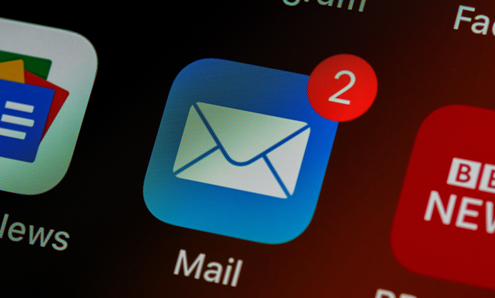Collecting email addresses from existing and prospective customers is super important to businesses because the numbers show that email marketing is the number one method of connecting with customers.
Compared to using social media, for example, emails boast a six times higher click-through rate than tweets and have been shown to be 40 times more effective at obtaining new customers than the likes of Facebook and Twitter.
So, how do business owners go about building a healthy email list? Here are our nine tried and tested hacks.
1. Ask for them
It really can be as simple as that. When a customer is paying for your goods or services, ask ‘would you like to sign up to our mailing list today?’ - you’ll be surprised how many people are willing to hand over their details.
If you want to really up the chances of getting a yes, offer a small incentive in exchange for their address, something like a free biscuit with their coffee if they sign up today, or a half-price dessert.
Think about it, have you ever been browsing sites online only to be greeted by a pop-up box asking for your email address in exchange for 25% off your first purchase? Chances are, you took the plunge, and the same methodology can be applied to your business.
2. On your website
Be upfront about what you want and include a sign-up box on every page of your website - it’s been shown to boost subscriber rates.
One site dedicated to women’s health, Health4her, noted a 2-4% sign-up rate of all website traffic after adding a link to their homepage and encouraged start-ups to make it top of their to-do list when setting up an online store.
3. Run a promotion
Run a promotion whereby one or several lucky winners get something for nothing and you’ll exponentially increase your email subscribers, after all, who doesn’t like getting things for free?
Contests for prizes, discounts or experiences always attract new sign-ups and can reach a wider audience than other marketing efforts. Something like this:
“We’re giving away a gift hamper full of our finest goodies to one lucky winner, simply like this post, share it to your feed, and sign up to our newsletter for a chance to win. Competition closes on Sunday 15th at midnight. Good luck!”
One company, BikiniLuxe, who adopted this contest idea on a monthly basis reported huge success with an average of 100 new sign-ups every day as a result.
4. Put ads in newsletters
Are there any newsletters that already attract your target audience? For example, if you’re a restaurant think about local food and drink guides, or if you’re a tradesman look for a local guide to trusted businesses.
Whatever the resource, whether it’s an online newsletter or local paper, try and get an ad in there promoting your business and asking people to subscribe. Something like this:
“TSH Plumbing is a family run business that’s been serving the community for over 10 years. Head to our website and sign up to our newsletter today and receive 10% off your next boiler service”.
Targeted marketing done in this way will result in more promising sign-ups who’re more likely to actually use your business, and it’ll boost your credibility at the same time.
5. Partner up
The trick to successfully partnering up is finding a relevant business that isn’t a competitor of yours. So for example, if you’re a hairdresser look for a nail salon to partner up with, or if you’re a greengrocers scout out a local bakery to team up with.
Once you’ve found your ally you can boost your subscribers by recommending each other’s business in your next email marketing campaign. Sticking with the greengrocer business example, it might look something like this:
“This month’s seasonal produce are butternut squash and parsnips - perfect for a hearty soup - and we’ve attached our favourite recipe below for you to try at home. Nothing compliments homemade soup like freshly baked bread, and our friends at Beth’s Bakery are offering 10% off all loaves to anyone who signs up to their mailing list!”
Partnering up in this way is a win-win situation for both businesses and could open the door to a whole heap of new sign-ups.
6. Email receipts
If you’re running an online-only business, chances are you’re already emailing receipts to your customers, and can, therefore, build up a subscriber list (with permission) in this way.
But bricks and mortar businesses can adopt the same methodology, in fact, you might have noticed some high street stores have already introduced this tactic.
All you need to do is ask your customers when they’re at the check out if they’d like a paper receipt or prefer it to be sent to their email address or both. Consumers are becoming increasingly environmentally conscious, so the option to go paperless is likely to be popular.
It won’t be for everyone, but for each customer who opts for a paperless receipt, you’ll have an extra name on your email list.
7. Set up a loyalty programme
Make sure there’s something in it for the customer and you’ll boost the chances they’ll sign-up. Your imagination can run free with this idea, but at the core is the notion that the customer feels like they’re gaining value by subscribing.
You might give anyone signed up exclusive access to new stock 24 hours before anyone else, or sale items, or Black Friday deals, whatever it may be.
If you run a business that’s suitable for a traditional loyalty card, like a cafe or beauty salon, offer new and existing customers extra stamps in exchange for their email address. You’ll increase your subscribers but this tactic has also been shown to greatly increase the likelihood they return to your business.
8. Use social media
Facebook’s userbase is currently at an all-time high, making it a super powerful tool for gaining new sign-ups. Businesses report Facebook Ads as the most effective and affordable way to grow their email lists and boost revenue, and better yet the leads it creates are targeted specifically based on demographics, meaning anyone who signs up as a result of these ads is much more likely to buy from you.
Twitter and Instagram also allow for paid-for ad targeting, so if your budget allows for it, use social media to build your email list while promoting your business.
Top tip: thinking about the contests we discussed earlier, social media is a great way to build traction and gain a wider audience for your efforts. Simply ask your followers to share your post (as well as sign-up to your newsletter) to enter.
9. Give them something for free
Consumers are increasingly turning to online tutorials and blogs for advice before making buying decisions, and you can use this to your advantage.
Provide a free resource to your target customers and if they find it useful, they’re likely to sign up to your mailing list to access more or the same value in the future.
For example, if you’re a hairdresser you might post a video tutorial on how to create a popular hairstyle, if you’re a builder it might be a guide on how to best protect your home over winter, or if you’re a furnishing store you could show consumers how to create a boutique bedroom look with ease.
Remember, you’re offering a free service to boost your email list, so always include sign-up boxes at the end of every article, and ask viewers to subscribe at the end of videos.
Top tip: to ensure you get the end result, you can post one or two of these free resources publically, but then tell people they need to subscribe to continue gaining access via email.
The benefits of building an email list
So now you know how to do it, let’s look at why you should. We alluded to it in the introduction, but email marketing is the most successful method for acquiring new customers, and every business needs to build a healthy customer base in order to grow.
Here are some additional perks:
- Emails are personal - you can use more personal language - i.e. start each email with the customer’s name, and you’ll reach them in their personal mailbox.
- Customers prefer them - social media is super popular for socialising, but consumers still prefer emails for business communications.
- Emails are targeted - so you can send your customers the most relevant promotions and offers based on their demographics.
- Emails convert more - they turn into sales more often than any other marketing, and that makes business sense.
- They’re cheap - compared to paid-for online advertising or flyers and brochures, emails require little money to be effective.
- You own your email list - compared to social media which can change its policies at the drop of a hat rendering your marketing efforts pointless, customers’ email addresses aren’t influenced by anyone but them.
Follow our nine-step guide and you’ll have a flourishing email list in no time, and that could mean you’ll be taking more payments than ever. Are your systems up to the task? Whether it’s online payments, card machines or an EPOS till system, chat to our experts today on 08082 397 003.





